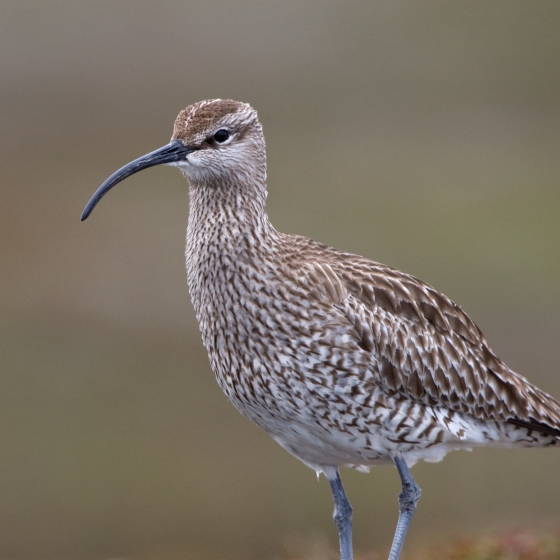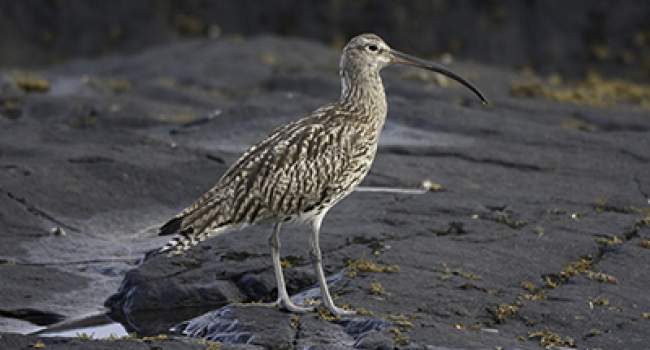Whimbrel
Numenius phaeopus (Linnaeus, 1758)
WM
 WHIMB
WHIMB  5380
5380

Family: Charadriiformes > Scolopacidae

Whimbrel is a smaller version of the Curlew, with a shorter, straighter then down-curved bill and pale crown-stripe. The ‘seven-whistle’ call is diagnostic.
This elegant wader has a very restricted UK breeding range, with a small population nesting mostly in Shetland. Birds start to arrive back on territory from the last week of April, having spent the winter in southern Europe and Africa.
Birdwatchers are most likely to encounter Whimbrel in spring, as birds pass through Britain & Ireland heading for their arctic breeding grounds, which stretch from Greenland to Siberia. Individuals or small flocks can be seen virtually anywhere around our coasts, and sometimes at inland locations in England.
Identification
Whimbrel identification is often straightforward. The following article may help when identifying Whimbrel.
Identifying Curlew and Whimbrel

Curlew is a familiar wader, found in wild habitats around the UK. In April and May numbers of their smaller cousin, Whimbrel, will be moving through towards their northerly breeding sites and these birds can cause confusion. This video helps you to confidently separate the two species by sight and sound.
SONGS AND CALLS
Listen to example recordings of the main vocalisations of Whimbrel, provided by xeno-canto contributors.
Call
Song
Develop your bird ID skills with our training courses
Our interactive online courses are a great way to develop your bird identification skills, whether you're new to the hobby or a competent birder looking to hone your abilities.
Browse training coursesStatus and Trends
Population size and trends and patterns of distribution based on BTO surveys and atlases with data collected by BTO volunteers.
CONSERVATION STATUS
This species can be found on the following statutory and conservation listings and schedules.
POPULATION CHANGE
Most Whimbrel seen in Britain are passage migrants en route to Iceland, Scandinavia and Russia, and the small British breeding population is almost entirely confined to Shetland. The population is monitored by specical surveys: An estimate of 479 breeding pairs in 1989–94 was similar to a previous estimate for 1983–86 (Dore et al. 1996) although the most recent such survey estimated a population of 290+ breeding pairs suggesting a slight decline (Jackson 2009). However, the population remains higher than the estimate of c.150 pairs during 1968–72 (Sharrock 1976).
DISTRIBUTION
Whimbrels have a very restricted breeding distribution in Britain, with most of the population and 76% of the range confined to the Shetland Islands, the remainder being in Orkney, the Western Isles and Caithness. A small but growing number of Whimbrels winter in the UK, mostly at coastal sites, with a concentration along the south coasts of England and Ireland.
Occupied 10-km squares in UK
| No. occupied in breeding season | 42 |
| % occupied in breeding season | 1.4 |
| No. occupied in winter | 109 |
| % occupied in winter | 3.6 |
European Distribution Map
DISTRIBUTION CHANGE
Since the 1980s there has been a large increase in wintering Whimbrels, with a 212% increase in the number of occupied 10-km squares in Britain & Ireland, probably as a result of milder winters.
Change in occupied 10-km squares in the UK
| % change in range in breeding season (1968–72 to 2008–11) | -28.8% |
| % change in range in winter (1981–84 to 2007–11) | +304.3% |
SEASONALITY
Aside from a few records in winter and a small northern breeding population, most Whimbrels are encountered during the narrow spring passage period, and in the slightly more protracted autumn migration period, the latter starting from early July.

Movement
Information about movement and migration based on online bird portals (e.g. BirdTrack), Ringing schemes and tracking studies.
RINGING RECOVERIES
View a summary of recoveries in the Online Ringing Report.
Foreign locations of birds ringed or recovered in Britain & Ireland

Biology
Lifecycle and body size information about Whimbrel, including statistics on nesting, eggs and lifespan based on BTO ringing and nest recording data.
SURVIVAL & LONGEVITY
View number ringed each year in the Online Ringing Report
Maximum Age from Ringing 
|
24 years 1 months 25 days (set in 2010) 
|
Typical Lifespan 
|
11 years with breeding typically at 2 year |
Adult Survival 
|
0.89  
|
BIOMETRICS
Wing Length 
|
Adults | 253.7±8.6 | Range 241–268mm, N=63 |
| Juveniles | 243.6±7.5 | Range 230.5-255mm, N=20 |
Body Weight 
|
Adults | 451±60.9 | Range 355–522g, N=48 |
Feather measurements and photos on featherbase 
CODES & CLASSIFICATION
Ring size 
|
E |
Field Codes 
|
2-letter: WM | 5-letter code: WHIMB | Euring: 5380 |
For information in another language (where available) click on a linked name
Research
Interpretation and scientific publications about Whimbrel from BTO scientists.
CAUSES AND SOLUTIONS
Causes of change
The drivers of changes in the Whimbrel population are unclear, but potential factors that may have affected breeding sites include afforestation, peat extraction, agricultural changes and climate change (Birds in Scotland).
Links to more studies from ConservationEvidence.com
- The effects of re-seeding heathland on breeding whimbrel Numenius phaeopus in Shetland. I. Nest distributions
- Rush cutting to create nesting patches for lapwings Vanellus vanellus and other waders, Lower Lough Erne RSPB reserve, County Fermanagh, Northern Ireland
- Experimental removal of introduced hedgehogs improves wader nest success
Would you like to search for another species?












Share this page